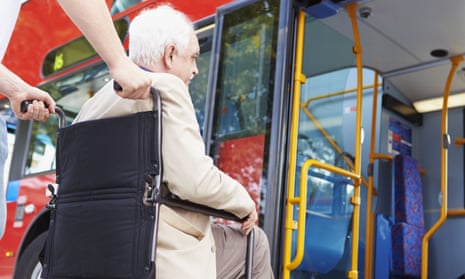“It only needs one bad driver to spoil your day,” says Gwyneth Pedler, a scooter user, in London. “You set off in a morning and you’re worrying. You get to one place and you’re worrying. You’re never free of worry.”
At 91 years old, Pedler, who has rheumatoid arthritis, has been using a scooter on buses and trains for more than a decade, first in Oxford and now in London, after moving nearer to her family two years ago. For Pedler, public transport is a way to keep social in retirement: day trips to Kew Gardens and Southend or a night at a restaurant or the theatre. “I’ve no intention of being a little old lady who sits inside,” she says.
But despite some good experiences, she ends up in regular battles to even be allowed on a bus. “Sometimes I persuade them [to let me on],” she says. “Sometimes they shut the door.”
After a recent night at the theatre, she tried to get a bus home only be told by the driver that scooters weren’t allowed. “So he left me on the pavement. At 11.30 at night,” she says. “Five people got off in protest. The driver didn’t care.”
Britain’s equality watchdog recently warned that many disabled people are still being treated as “second-class citizens”, citing inaccessible transport, among other areas, as a key “badge of shame”. Public transport can be a lifeline to disabled people – 60% have no car available to their households, compared to 27% of the overall population, in part because they’re more likely to be on a low income – but multiple barriers exist that mean they’re still routinely excluded from it.
Mo Onyett, a student adviser at the University of York, uses the train to commute to work from her home in Leeds, and regularly travels to London for meetings. But because she’s a wheelchair user, the 38-year-old can’t book online like everyone else; instead, she has to call up to buy a ticket, as well as to book assistance from staff to help her off the train with a ramp.
Still, in rush hour, she’s been left on the train in York when staff “forgot her”, with the same thing happening twice in one week at King’s Cross. “If it hadn’t been for the fact I have a loud voice I’d have been on my way to the next station,” she says.
Small changes, like train companies keeping ramps on the train, would make “a huge difference” to both train staff and passengers, Onyett says. The introduction of some folding seats that could then be removed for wheelchair users may also provide easier access for disabled commuters trying to get to work, she adds.
Mohammed Mohsanali, who has a visual impairment and uses a cane, cites something as simple as bus drivers making sure they pull up to the actual bus stop – rather than pulling in behind another bus – as a way to make it easier for him to visit friends. As it stands, Mohsanali, unable to see the bus has arrived and too far away to ask the driver to ask which bus it is, is often left stranded
Keen to get to friends in other parts of the city, Mohsanali describes the underground as “part of my daily life”. But staff cuts mean a lot of the smaller stations no longer have anyone there to help him, he says. Without any staff to point him towards the right train, he has to ask members of the public for help.
“They often try and grab your arm which isn’t safe,” Mohsanali says. It’s caused him to fall down the escalators. “He [the helper] was walking so fast and didn’t warn me an escalator was coming up. I’ve injured my knee like that a couple of times.”
For Pedler, now she’s not in Oxford, the tube is another way to stay social but with only a small portion of the underground accessible to wheelchairs and scooters, she relies on help from Transport for All, an organisation that provides advice for disabled travellers in London, to plan her routes. Sometimes she gets off the tube only to find the lift isn’t working. “You then have to go back to another station to get out,” she says. Better communication, such as widely publicising at all stations when other lifts are down, seems vital to help navigate such a system.
When it comes to buses, Pedler stresses useful measures already exist to enable access – for example, a button the driver can press that announces a wheelchair is coming on board so pushchairs can be moved – but drivers need to be told to follow through on them.
“Every day disabled people are being refused entry,” she says. “It stops us being independent.”
Talk to us on Twitter via @Guardianpublic and sign up for your free weekly Guardian Public Leaders newsletter with news and analysis sent direct to you every Thursday.

